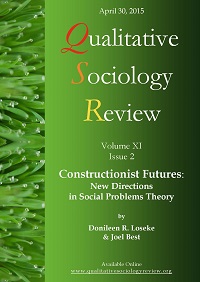Beyond Case Studies: Expanding the Constructionist Framework for Social Problems Research
DOI:
https://doi.org/10.18778/1733-8077.11.2.02Keywords:
Case Studies, Domain Expansion, Social Constructionism, Social Problems, Social Problems Cluster, WavesAbstract
Most constructionist analyses of social problems are case studies; these focus attention on the particulars of the case at hand. Analysts have devoted less attention to the ways cases can be connected. This paper presents a typology of such connections, based on five elements: the problem, the frame, the claims-makers, place, and time. The typology identifies ways each of these elements can serve as a basis for connecting different campaigns to construct social problems.
Downloads
References
Adler, Patricia A. and Peter Adler. 2011. The Tender Cut: Inside the Hidden World of Self-Injury. New York: New York University Press.
Google Scholar
Bailey, Cathryn. 1997. “Making Waves and Drawing Lines: The Politics of Defining the Vicissitudes of Feminism.” Hypatia 12(3):17-28.
Google Scholar
DOI: https://doi.org/10.1111/j.1527-2001.1997.tb00003.x
Benford, Robert D. 1993. “Frame Disputes Within the Nuclear Disarmament Movement.” Social Forces 71(3):677-701.
Google Scholar
DOI: https://doi.org/10.2307/2579890
Benson, Rodney. 2014. Shaping Immigration News: A French-American Comparison. New York: Cambridge University Press.
Google Scholar
DOI: https://doi.org/10.1017/CBO9781139034326
Best, Joel. 1990. Threatened Children: Rhetoric and Concern About Child-Victims. Chicago: University of Chicago Press.
Google Scholar
Best, Joel, (ed.). 2001. How Claims Spread: Cross-National Diffusion of Social Problems. Hawthorne, NY: Aldine de Gruyter.
Google Scholar
Best, Joel. 2013. Social Problems. New York: Norton.
Google Scholar
Best, Joel and Eric Best. 2014. The Student Loan Mess: How Good Intentions Created a Trillion-Dollar Problem. Berkeley: University of California Press.
Google Scholar
DOI: https://doi.org/10.1525/9780520958449
Best, Joel and Kathleen A. Bogle. 2014. Kids Gone Wild: From Rainbow Parties to Sexting, Understanding the Hype Over Teen Sex. New York: New York University Press.
Google Scholar
Blumer, Herbert. 1971. “Social Problems as Collective Behavior.” Social Problems 18(3):298-306.
Google Scholar
DOI: https://doi.org/10.1525/sp.1971.18.3.03a00020
Bogard, Cynthia. 2003. Seasons Such As These: How Homelessness Took Shape in America. Hawthorne, NY: Aldine de Gruyter.
Google Scholar
Boyle, Elizabeth Heger, Fortunata Songora, and Gail Foss. 2001. “International Discourse and Local Politics: Anti-Female-Genital-Cutting Laws in Egypt, Tanzania, and the United States.” Social Problems 48(4):524-544.
Google Scholar
DOI: https://doi.org/10.1525/sp.2001.48.4.524
Burgess, Adam. 2004. Cellular Phones, Public Fears, and a Culture of Precaution. Cambridge: Cambridge University Press.
Google Scholar
Charmaz, Kathy. 2013. Constructing Grounded Theory. London: Sage.
Google Scholar
Clarke, Adele E. et al. 2003. “Biomedicalization: Technoscientific Transformations of Health, Illness, and U.S. Biomedicine.” American Sociological Review 68(2):161-194.
Google Scholar
DOI: https://doi.org/10.2307/1519765
Downs, Anthony. 1972. “Up and Down with Ecology—The ‘Issue-Attention Cycle.’” Public Interest 28:8-50.
Google Scholar
Glaser, Barney G. and Anselm L. Strauss. 1967. The Discovery of Grounded Theory. Chicago: Aldine.
Google Scholar
Granovetter, Mark S. 1973. “The Strength of Weak Ties.” American Journal of Sociology 78(6):1360-1380.
Google Scholar
DOI: https://doi.org/10.1086/225469
Gusfield, Joseph R. 1981. The Culture of Public Problems: Drinking-Driving and the Symbolic Order. Chicago: University of Chicago Press.
Google Scholar
Hilgartner, Stephen and Charles L. Bosk. 1988. “The Rise and Fall of Social Problems.” American Journal of Sociology 94(1):53-78.
Google Scholar
DOI: https://doi.org/10.1086/228951
Jenkins, Philip. 1998. Moral Panic: Changing Concepts of the Child Molester in Modern America. New Haven, CT: Yale University Press.
Google Scholar
Jenkins, Philip. 2000. Mystics and Messiahs: Cults and New Religions in American History. New York: Oxford University Press.
Google Scholar
Jenkins, Philip. 2001. Beyond Tolerance: Child Pornography on the Internet. New York: New York University Press.
Google Scholar
Lofland, John. 1993. Polite Protesters: The American Peace Movement of the 1980s. Syracuse, NY: Syracuse University Press.
Google Scholar
Lofland, John. 2003. Demolishing a Historic Hotel: A Sociology of Preservation Failure in Davis, California. Davis, CA: Davis Research.
Google Scholar
Loseke, Donileen R. 2003. Thinking About Social Problems: An Introduction to Constructionist Perspectives. Hawthorne, NY: Aldine de Gruyter.
Google Scholar
Macalpine, Ida and Richard Hunter. 1966. “The ‘Insanity’ of King George III: A Classic Case of Porphyria.” British Medical Journal 5479(8):65-71.
Google Scholar
DOI: https://doi.org/10.1136/bmj.1.5479.65
Mann, Ruth M. 2000. Who Owns Domestic Abuse? The Local Politics of a Social Problem. Toronto: University of Toronto Press.
Google Scholar
DOI: https://doi.org/10.3138/9781442683402
Maratea, R.J. 2014. The Politics of the Internet: Political Claimsmaking in Cyperspace and Its Effect on Modern Political Activism. Lanham, MD: Lexington.
Google Scholar
Miller, Gale and James A. Holstein, (eds.). 1997. Social Problems in Everyday Life: Studies of Social Problems Work. Greenwich, CT: JAI Press.
Google Scholar
Moynihan, Daniel Patrick. 1993. “Defining Deviancy Down.” American Scholar 62(1):17-30.
Google Scholar
Parilla, Pater F. 2013. “Cell Phone Use While Driving: Defining a Problem as Worthy of Action.” Pp. 27-46 in Making Sense of Social Problems: New Images, New Issues, edited by Joel Best and Scott R. Harris. Boulder, CO: Lynne Rienner.
Google Scholar
Parsons, Nicholas L. 2014. Meth Mania: A History of Methamphetamine. Boulder, CO: Lynne Rienner.
Google Scholar
Roscigno, Vincent J. and Randy Hodson. 2004. “The Organizational and Social Foundations of Worker Resistance.” American Sociological Review 69(1):14-39.
Google Scholar
DOI: https://doi.org/10.1177/000312240406900103
Saguy, Abigail C. 2003. What Is Sexual Harassment? From Capitol Hill to the Sorbonne. Berkeley: University of California Press.
Google Scholar
DOI: https://doi.org/10.1525/9780520936973
Saguy, Abigail C. 2013. What’s Wrong With Fat? New York: Oxford University Press.
Google Scholar
DOI: https://doi.org/10.1093/acprof:oso/9780199857081.001.0001
Spector, Malcolm and John I. Kitsuse. 1977. Constructing Social Problems. Menlo Park, CA: Cummings.
Google Scholar
Taylor, Verta. 1989. “Social Movement Continuity: The Women’s Movement in Abeyance.” American Sociological Review 54(5):761-775.
Google Scholar
DOI: https://doi.org/10.2307/2117752
Trent, James W., Jr. 1994. Inventing the Feeble Mind: A History of Mental Retardation in the United States. Berkeley: University of California Press.
Google Scholar
Whittier, Nancy. 2014. “Rethinking Coalitions: Anti-Pornography Feminists, Conservatives, and Relationships Between Collaborative Adversarial Movements.” Social Problems 61(2):175-193.
Google Scholar
DOI: https://doi.org/10.1525/sp.2014.12151
Downloads
Published
How to Cite
Issue
Section
License

This work is licensed under a Creative Commons Attribution-NonCommercial-NoDerivatives 4.0 International License.











